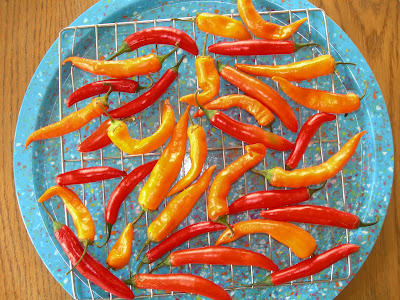Having years ago learned that the flavor of fresh-dried or fresh-ground spices is leagues better than the barely-there flavor of those little expensive cans of dust you find in the supermarket, I don't buy any herbs or spices dried or ground unless I'm having a pantry emergency.
Crushed red pepper is no exception. While you will get heat from store-bought crushed red, you will not get the depth of flavor that comes from drying your own local peppers each autumn. And have you SEEN the glorious selection of peppers at the Farmers' Markets? Ask for the hottest ones, rinse and wipe dry, spread them out on an airy surface like a cooling rack, and go do something else for a few weeks.
If you get impatient, you can cut the stem top off and slice the peppers in half. They will dry faster this way, but they won't look as scenic, and they'll take up more room. I've found that if you make a wreath or swatch of the peppers, the air doesn't circulate as well and some of the peppers may mold. If you find that any of the peppers you are drying turn black, discard them.
If you get impatient, you can cut the stem top off and slice the peppers in half. They will dry faster this way, but they won't look as scenic, and they'll take up more room. I've found that if you make a wreath or swatch of the peppers, the air doesn't circulate as well and some of the peppers may mold. If you find that any of the peppers you are drying turn black, discard them.
When peppers are dry (you can hear the seeds rattling when you shake the pepper), remove the stem tops and let the peppers dry again for a few days just to make sure they are really dry. Now make your heat decision. Much of the heat in hot peppers is in the seeds. If you want maximum heat, leave all the seeds in. To tone things down a bit, discard some of the seeds. But if you have read this far and like spicy food, you will scoff at that instruction.
Toss the dry peppers into a food processor and pulse until you get particles of a size that is pleasing to you. Should you want smaller particles than the food processor will produce, grind a few tablespoons of the flakes at a time in a coffee grinder (that you reserve for grinding spices) 'til the sizes please you.
Toss the dry peppers into a food processor and pulse until you get particles of a size that is pleasing to you. Should you want smaller particles than the food processor will produce, grind a few tablespoons of the flakes at a time in a coffee grinder (that you reserve for grinding spices) 'til the sizes please you.
Store in a covered jar and use carefully. It doesn't take long to make your soup or sauce inedibly hot; I usually start with 1/8 teaspoon of seeds to, say, your average eight-cup batch of soup. The longer the peppers cook in anything, the hotter the dish will be.

No comments:
Post a Comment